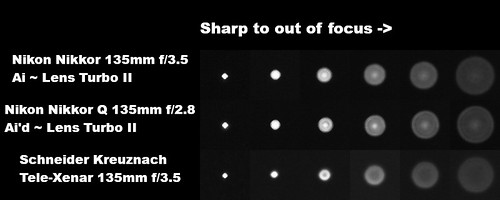I heard that spending time along the Cote d'Azur could be good for one's art. While I make no claims to be an artist, spending time in the sun along the Mediterranean Sea inspired me to more deeply consider optics as applied to the craft of photography.
For many years I looked at just one dimension of commercially available optics - resolution. Now I wanted to start looking at other aspects of optical performance. For this series I look at spherical aberration (looking for under, neutral, or over corrections) in out of focus rendition on subject matter behind the point of focus.
Setup -
If you click on the following image you can inspect it at 100 percent.

Comments -
NOTE: I feel the Lens Turbo II focal reducer adds a bit of under-corrected spherical aberration.
The Nikon Nikkor 135mm f/3.5 Ai lens shows under corrected spherical aberrations. In normal photography I would expect, based on these comparisons, that there will be a very smooth and delicate (to use Nikon's own word on the topic) out of focus field rendition.
The Nikon Nikkor 135mm f/2.8 Q Ai'd lens shows under corrected spherical aberrations. The out of focus disk shows variable luminosity and is not as smooth as the f/3.5 Ai. In normal photography I would expect, based on these, that there will be a smooth and delicate (to use Nikon's own word on the topic) out of focus field rendition.
The Schneider Kreuznach Tele-Xenar 135mm f/3.5 lens shows over corrected spherical aberrations. In normal photography I would expect, based on these comparisons, that there will be the tendency to hollow out highlights and brighter areas of the out of focus field rendition. Some would call this a tendency toward a "harsh" out of focus rendition.
Resources -
For further information on how the topic of out of focus rendition, optical properties, and Nikon lens design history, please refer to the following -
A PhD thesis on the impact of "soft focus" lenses on the history of photography - http://research-repository.st-andrews.ac.uk/handle/10023/505
An excellent starting point for understanding out of focus rendition (I might not completely agree with his interpretations/observations, but his foundation of understanding is quite good) - http://jtra.cz/stuff/essays/bokeh/
Nikon lens design histories - https://imaging.nikon.com/history/story/
Point light source discussions - https://www.dpreview.com/forums/thread/4031515
Zeiss comments on optical design - https://lenspire.zeiss.com/photo/en/article/how-does-zeiss-define-bokeh-an-interview-with-dr-stefan-ballmann
Metabones Focal Reducer whitepaper - https://www.metabones.com/assets/a/stories/Speed%20Booster%20White%20Paper.pdf
For many years I looked at just one dimension of commercially available optics - resolution. Now I wanted to start looking at other aspects of optical performance. For this series I look at spherical aberration (looking for under, neutral, or over corrections) in out of focus rendition on subject matter behind the point of focus.
Setup -
- Sony NEX5T, ISO 100, 2 second timer, -1 EV
- Big Beefy Manfrotto tripod
- Lenses using with a Lens Turbo II focal reducer -
- Nikon Nikkor 135mm f/3.5 Ai
- Nikon Nikkor 135mm f/2.8 Q Ai'd
- Lens using a straight through adapter (ie: no focal length reduction to APS-C sensor) -
- Schneider Keuznach Tele-Xenar 135mm f/3.5 (late 1950's to early 1960's)
- NOTE1: Lenses were shot at their widest apertures only
- NOTE2: Out of focus samples are from points _behind_ the point of focus to compare background out of focus rendition
- RawTherapee to convert RAW files into black and white and to set the black levels
If you click on the following image you can inspect it at 100 percent.

Comments -
NOTE: I feel the Lens Turbo II focal reducer adds a bit of under-corrected spherical aberration.
The Nikon Nikkor 135mm f/3.5 Ai lens shows under corrected spherical aberrations. In normal photography I would expect, based on these comparisons, that there will be a very smooth and delicate (to use Nikon's own word on the topic) out of focus field rendition.
The Nikon Nikkor 135mm f/2.8 Q Ai'd lens shows under corrected spherical aberrations. The out of focus disk shows variable luminosity and is not as smooth as the f/3.5 Ai. In normal photography I would expect, based on these, that there will be a smooth and delicate (to use Nikon's own word on the topic) out of focus field rendition.
The Schneider Kreuznach Tele-Xenar 135mm f/3.5 lens shows over corrected spherical aberrations. In normal photography I would expect, based on these comparisons, that there will be the tendency to hollow out highlights and brighter areas of the out of focus field rendition. Some would call this a tendency toward a "harsh" out of focus rendition.
Resources -
For further information on how the topic of out of focus rendition, optical properties, and Nikon lens design history, please refer to the following -
A PhD thesis on the impact of "soft focus" lenses on the history of photography - http://research-repository.st-andrews.ac.uk/handle/10023/505
An excellent starting point for understanding out of focus rendition (I might not completely agree with his interpretations/observations, but his foundation of understanding is quite good) - http://jtra.cz/stuff/essays/bokeh/
Nikon lens design histories - https://imaging.nikon.com/history/story/
Point light source discussions - https://www.dpreview.com/forums/thread/4031515
Zeiss comments on optical design - https://lenspire.zeiss.com/photo/en/article/how-does-zeiss-define-bokeh-an-interview-with-dr-stefan-ballmann
Metabones Focal Reducer whitepaper - https://www.metabones.com/assets/a/stories/Speed%20Booster%20White%20Paper.pdf
No comments:
Post a Comment